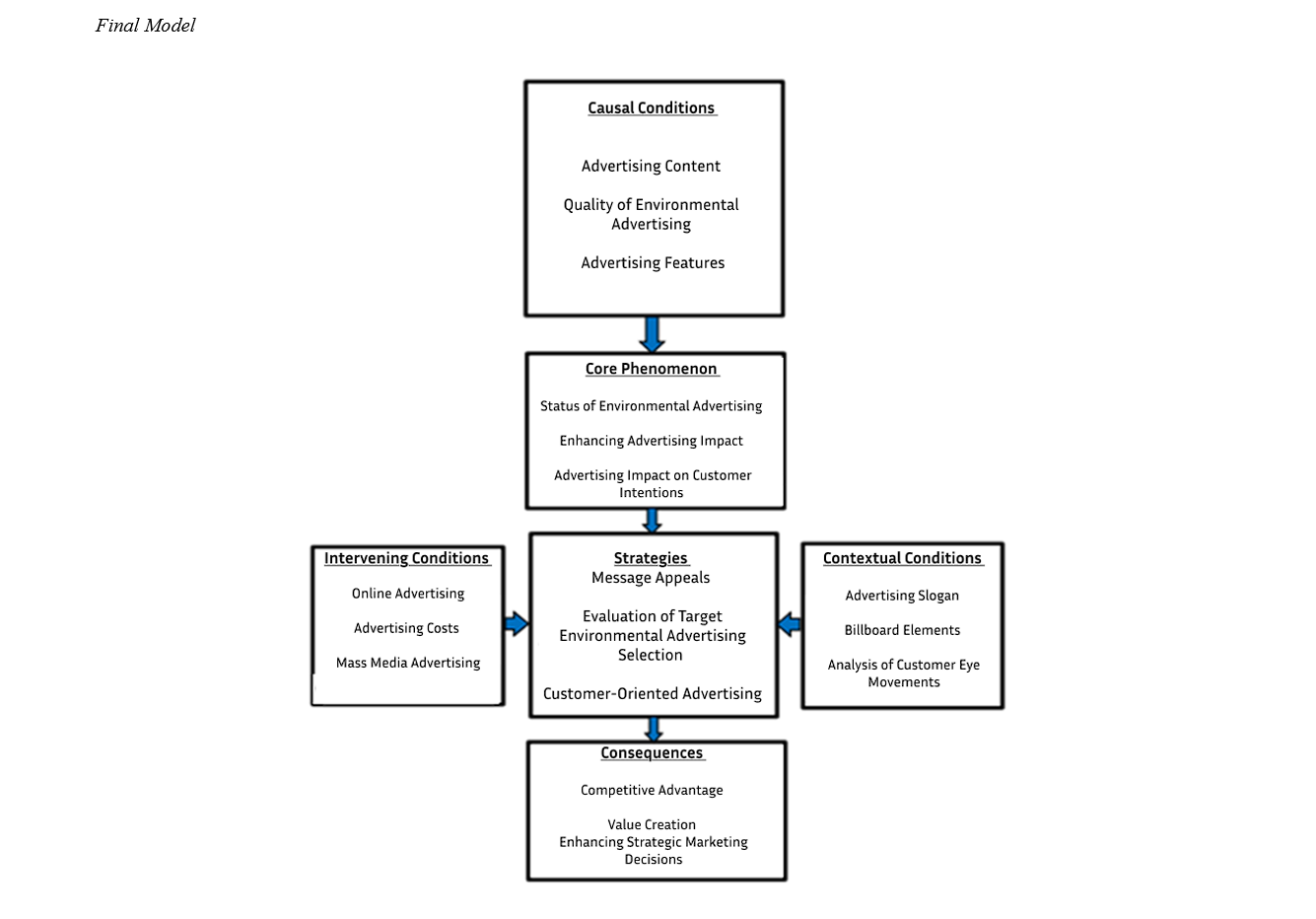Presenting an Advertising Policy Model Based on the Application of Eye Tracking
Keywords:
policy, advertising, application of eye trackingAbstract
The present study was conducted with the aim of developing a model for advertising policy based on the application of eye tracking. The research method was qualitative and grounded in data theory. Semi-structured interviews were used for data collection, and data analysis was carried out using Strauss and Corbin’s method and the paradigm model. Sampling was conducted through theoretical sampling and utilized purposive (judgmental) techniques, based on which 15 interviews with marketing and advertising managers and experts were conducted. The results of analyzing the data obtained from the interviews, through the process of open, axial, and selective coding, led to the development of an advertising policy model based on the application of eye tracking, grounded in data theory. The findings of this research indicate that for the success of an advertising policy based on the use of eye tracking, managers must carefully pay attention to all identified categories and subcategories in this study and possess adequate and sufficient knowledge regarding each of them.
References
Abad, P. (2025). A Deeper Theoretical Understanding of the Capital Asset Pricing Model.
Abbasi Esfanjani, H. (2022). The Impact of Product Innovation Capabilities, Market Intelligence, Pricing, and Marketing Communications on Competitive Advantage and International Performance of Small and Medium-Sized Enterprises in Hormozgan Province. International Business Management, 20, 159-178. https://jiba.tabrizu.ac.ir/article_15714.html?lang=en
Afaqhi Firimani, A. A., Marzi Almdari, J., & Deigh, A. (2023). Examining the Relationship Between Product Pricing Strategies and Marketing Capabilities (Case Study: Manufacturing Companies Located in the Aras Free Zone). 7th National Conference on New Horizons in Humanities, Economics, and Entrepreneurship, Tehran.
Alizadeh, N., & Tavan, A. (2023). Determining Product Innovation Capacities, Market Intelligence, Pricing, and Marketing Communications on International Company Performance with the Mediating Role of Competitive Advantage. Modern Management Engineering, 30, 83-116. https://sanad.iau.ir/en/Journal/jmem/Article/1025146/FullText
Feng, L., & Chan, Y. (2022). Joint pricing and production decisions for new products with learning curve effects under upstream and downstream trade credits. European Journal of Operational Research, 272(3), 905-913. https://doi.org/10.1016/j.ejor.2018.07.003
Hinterhuber, A., & Liozu, S. M. (2020). Innovation in pricing: Contemporary theories and best practices. Routledge.
Kotler, P., Keller, K. L., & Chernev, A. (2022). Marketing management. Pearson.
Lee, J., & Griffith, D. A. (2022). Price strategy in global markets: Balancing standardization and adaptation. International Marketing Review, 39(2), 381-407.
Mahapatra, A. S., Sengupta, S., Dasgupta, A., Sarkar, B., & Goswami, R. T. (2025). What is the impact of demand patterns on integrated online-offline and buy-online-pickup in-store (BOPS) retail in a smart supply chain mana gement? Journal of Retailing and Consumer Services, 82, 104093. https://doi.org/10.1016/J.JRETCONSER.2024.104093
Martín-Peña, M. L., Díaz-Garrido, E., & Sánchez-López, J. M. (2021). Pricing strategies in the digital era: A review and research agenda. Journal of Business Research, 123, 252-265.
Nagle, T. T., Hogan, J., & Zale, J. (2021). The strategy and tactics of pricing: A guide to growing more profitably. Routledge.
Peng, J., Zou, Y., Zhang, H., Zeng, L., Wang, Y., & Li, X. (2025). Pricing Decision-Making Considering Ambiguity Tolerance in Consumers: Evidence From Recycled Building Material Enterprises. Systems, 13(2), 98. https://doi.org/10.3390/systems13020098
Rakhmanita, A., Hurriyati, R., & Dirgantari, P. D. (2022). Strategy of Gamification, Product and Pricing: Does It Matter on Buying Interests of Fore Coffee Consumers. Sentralisasi, 11(1), 28-36. https://doi.org/10.33506/sl.v11i1.1493
Rogers, E. M. (2020). Diffusion of innovations. Free Press.
Salmasnia, A., & Talesh-Kazemi, A. (2022). Integrating inventory planning, pricing, and maintenance for perishable products in a two-component parallel manufacturing system with common cause failures. Operations Research International Journal, 22, 1235-1265. https://doi.org/10.1007/s12351-020-00590-6
Schill, R., & Nixon, M. (2024). The seven 'C's of strategic pricing in international markets. Journal of Cultural Marketing Strategy, 8(2), 175-191. https://doi.org/10.69554/OCWL9175
Shao, L. (2021). The Pricing Decision and Channel Choice of Upgraded Products in the Presence of Strategic Consumers. Mathematical Problems in Engineering, 2021, 1-10. https://doi.org/10.1155/2021/6674676
Tarde, O., Smith, R., & Chen, L. (2020). Innovation-based pricing: Market entry strategies for high-tech products. Technovation, 94-95, 102001.
Tian, L., & Wu, Y. (2020). Pricing Strategies in Presence of Online Consumer Ratings - From the Product Customization Perspective. Journal of Theoretical and Applied Electronic Commerce Research, 15(3), 84-100. https://doi.org/10.4067/s0718-18762020000300107
Tien, N. H., Anh, D. B. H., & Phu, P. P. (2023). Pricing strategies for innovative products in emerging markets. Journal of Business and Economic Development, 8(1), 25-34.
Wang, L. (2024). Leveraging Emerging Technologies in Pricing Strategies and Consumer Behavior: Case Studies From China's Innovative Markets. Ijetaa, 1(6), 6-12. https://doi.org/10.62677/ijetaa.2406121
Xu, J., Meng, Q., Chen, Y., & Jia, Z. (2023). Dual-Channel Pricing Decisions for Product Recycling in Green Supply Chain Operations: Considering the Impact of Consumer Loss Aversion. International journal of environmental research and public health, 20(3), 1792. https://doi.org/10.3390/ijerph20031792
Xu, Y. (2024). Comparison Between Different Pricing Models: Evidence From the Technology Industry. Advances in Economics Management and Political Sciences, 59(1), 222-230. https://doi.org/10.54254/2754-1169/59/20231126
Yang, C., Feng, Y., & Whinston, A. (2022). Dynamic pricing and information disclosure for fresh produce: An artificial intelligence approach. Production and Operations Management, 31(1), 155-171. https://doi.org/10.1111/poms.13525
Yoon, S., & Lee, K. (2018). Price strategy for innovative products: The moderating role of product newness and consumer innovativeness. Innovation: Organization & Management, 20(2), 134-150. https://doi.org/10.1080/14479338.2018.1425906
Yuan, X., Ma, Z., & Zhang, X. (2022). Dynamic Pricing for the Successive-Generation Products in the Presence of Strategic Customers and Limited Trade-in Duration. Kybernetes, 52(11), 5329-5352. https://doi.org/10.1108/k-02-2022-0237
Zhao, H., Yao, X., Liu, Z., & Yang, Q. (2021). Impact of Pricing and Product Information on Consumer Buying Behavior With Customer Satisfaction in a Mediating Role. Frontiers in psychology, 12, 720151. https://doi.org/https://doi.org/10.3389/fpsyg.2021.720151

Downloads
Published
Submitted
Revised
Accepted
Issue
Section
License
Copyright (c) 2024 Seyyed Hamid Mir Motahari (Author); Sina Nematizadeh; Seyyed Abbas Heydari (Author)

This work is licensed under a Creative Commons Attribution-NonCommercial 4.0 International License.








